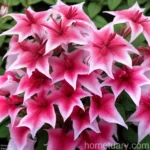Cardinal Flower (Lobelia Cardinalis ‘Fried Green Tomatoes’)
In the world of horticulture, the cardinal flower (Lobelia cardinalis ‘Fried Green Tomatoes’) stands out as an eye-catching and vibrant addition to any garden. This plant, also known simply as cardinal flower or botanically as Lobelia cardinalis, is appreciated for its stunning appearance, adaptability, and various cultural uses. In this comprehensive guide, we will delve into the characteristics, cultivation, and caring for the cardinal flower, aiming to provide enthusiasts and gardeners with a detailed understanding of this remarkable species. From its origins and propagation to its role in landscaping and its support of biodiversity, we will explore its many facets and intricacies.
What is Plant Cardinal Flower (Lobelia Cardinalis ‘Fried Green Tomatoes’)?
The cardinal flower (Lobelia cardinalis) is a perennial plant that belongs to the Campanulaceae family. Renowned for its strikingly bright scarlet-red flowers and lance-shaped leaves, the cardinal flower adds a vibrant touch to any landscape. The cultivar ‘Fried Green Tomatoes’ offers a unique twist with muted green foliage, setting it apart from the typical green coloration of the species.
Key Takeaways – Cardinal Flower (Lobelia Cardinalis ‘Fried Green Tomatoes’)
- Scientific Name: Lobelia cardinalis ‘Fried Green Tomatoes’
- Family: Campanulaceae
- Common Name: Cardinal Flower
- Cultivar: ‘Fried Green Tomatoes’
Culture
The cardinal flower thrives in moist to wet soils, often found in the margins of streams or ponds in its natural habitat. It is native to North America and particularly favors habitats in the eastern half of the continent. This plant species is a favorite among gardeners for its adaptability and its ability to attract pollinators, making it an excellent choice for creating wildlife-friendly gardens.
Uses
The cardinal flower has a range of uses, both practical and aesthetic. Apart from its ornamental value, it also plays a crucial role in supporting local ecosystems, particularly in the context of pollinator and wildlife conservation. Its application spans from traditional medicine to erosion control, making it a versatile and valuable addition to any garden or landscape.
Water
The cardinal flower exhibits a preference for consistently moist or wet soil, making it an excellent choice for water gardens or rain gardens. However, it can also tolerate regular garden soil provided it receives ample moisture.
Sunlight
In terms of sunlight, the cardinal flower prefers partial shade to full sun, allowing it to thrive in a variety of lighting conditions. However, when exposed to intense heat and sunlight, it benefits from slightly more moisture to compensate for potential evaporation.
Fertilizer
Typically, the cardinal flower does not require extensive fertilization, particularly when planted in its preferred moist conditions. However, if the plant is in a container or otherwise situated in drier soil, a balanced slow-release fertilizer may be applied in the early spring for optimal growth.
Soil
The cardinal flower thrives in damp, humus-rich soil with a slightly acidic to neutral pH. The ability to hold moisture is crucial for the health and vigor of this plant, making loamy or sandy soil types with good water retention ideal for its cultivation.
Pruning
While the cardinal flower does not require regular pruning, removing spent flowers and any damaged or fading foliage can promote new growth and enhance the overall appearance of the plant.
Propagation
Propagating the cardinal flower can be achieved through several methods, including division, seed collection, and stem cuttings. These techniques present gardeners with various options to expand their cardinal flower population or share the plant with others.
-
Division: The cardinal flower can be divided in early spring to separate and replant mature clumps, promoting new growth and enabling the spread of the species.
-
Seed Collection: Collecting seeds after the flowering season allows for the cultivation of new plants from scratch, providing an opportunity to share the beauty of the cardinal flower with others.
-
Stem Cuttings: Stem cuttings can also be used to propagate the cardinal flower, offering a quick and effective means of increasing the plant’s population.
Container Popularity
The cardinal flower’s adaptability and striking appearance make it well-suited for container cultivation. This presents an excellent option for enthusiasts who may not have access to traditional garden spaces but still wish to experience the beauty of this captivating plant.
Common Diseases
While the cardinal flower is relatively resistant to disease, it is susceptible to certain issues that can impact its health and aesthetics. Understanding these potential ailments and the appropriate measures to mitigate them is crucial for maintaining the cardinal flower’s vitality.
Disease Diagnosis
Common diseases that can affect the cardinal flower include:
-
Powdery Mildew: This fungal disease presents as a powdery white substance on the leaves, affecting the plant’s vigor and appearance.
-
Root Rot: Excessive moisture or poorly drained soil can lead to root rot, manifesting as discolored, mushy roots and wilting foliage.
-
Leaf Spot: Leaf spot diseases can cause discoloration and damage to the foliage, impacting the overall health of the plant.
Understanding the symptoms and development of these diseases aids in their rapid identification and subsequent treatment, ensuring the cardinal flower remains healthy and resilient.
Common Pests
While generally resilient, the cardinal flower can attract certain pests that may impact its growth and appearance. Vigilance and appropriate pest management techniques are essential to safeguard the plant against potential infestations.
Common pests that may affect the cardinal flower include:
-
Aphids: Small, sap-sucking insects that can distort the growth of the plant and cause foliage damage.
-
Slugs and Snails: These pests can feed on the leaves and flowers of the cardinal flower, leading to unsightly holes and damage.
-
Caterpillars: Some species of caterpillars may feed on the foliage, requiring vigilance and control measures to prevent significant damage.
By recognizing the presence of these pests and implementing suitable control measures, the cardinal flower can be effectively protected from potential harm.
Botanist’s Tips
As a plant enthusiast and horticulturist, I have gathered a collection of valuable tips for successfully cultivating and caring for the cardinal flower. These insights draw from experience and extensive research, serving as a reliable guide for individuals seeking to introduce and nurture the cardinal flower in their own green spaces.
-
Adequate Moisture: Providing consistent moisture is essential for the cardinal flower’s health and vitality. Whether through regular watering or cultivation in water-rich environments, ensuring the plant’s hydration promotes robust growth.
-
Partial Shade Preference: While the cardinal flower can tolerate full sun, it generally thrives in partial shade, particularly in regions with warmer climates. Providing shade during the hottest part of the day can help prevent stress and dehydration.
-
Wildlife Attraction: Embracing the cardinal flower’s role in supporting pollinators and wildlife enhances the ecological value of its presence. Encouraging the visitation of hummingbirds, butterflies, and other beneficial creatures contributes to a thriving and dynamic garden ecosystem.
-
Mulching: Applying a layer of organic mulch around the base of the cardinal flower can help retain moisture, regulate soil temperature, and deter weed growth, promoting a healthy and fertile environment for the plant.
Fun Facts
- The name “cardinal flower” is derived from the bright red color of the plant, reminiscent of the robes worn by Roman Catholic cardinals.
- Cardinal flowers are a favorite nectar source for hummingbirds, drawing these acrobatic avian visitors with their vibrant blooms.
- Native American tribes historically utilized the cardinal flower for a variety of medicinal and ceremonial purposes, recognizing its value beyond its ornamental appeal.
Links to External Resources
For further information on the cardinal flower and its cultivation, the following resources offer valuable insights and guidance:
- The Royal Horticultural Society – Lobelia Cardinalis
- University of Wisconsin-Madison Botany Department – Cardinal Flower Fact Sheet
- North Carolina State University Extension – Growing Cardinal Flowers in the Garden
In conclusion, the cardinal flower is a treasured addition to any garden, offering not only visual splendor but also habitat support and ecological benefits. With the proper understanding of its requirements and characteristics, cultivating and enjoying the cardinal flower becomes an enriching and rewarding endeavor. Whether adorning a water garden, attracting pollinators, or contributing to the conservation of native flora, the cardinal flower holds a special place in horticulture and the natural world.
The deep crimson blooms of the cardinal flower symbolize not only its vibrant presence in the garden but also its significance in sustaining biodiversity and enriching our shared environment, making it a valuable and cherished component of any landscape.















